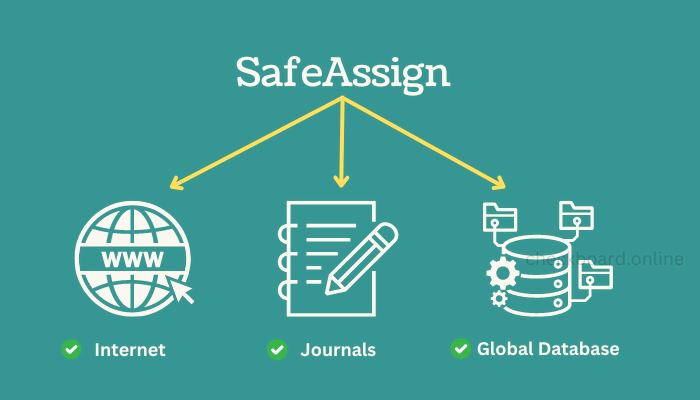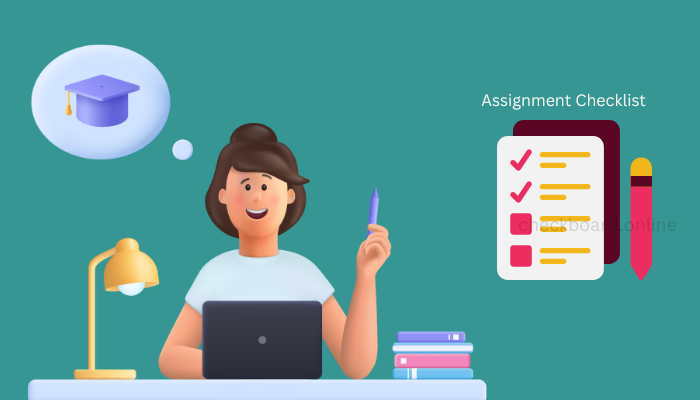SafeAssign Plagiarism Checker: As a student, you’ve likely heard the term “plagiarism” often thrown around. It’s a serious academic offence that can lead to significant consequences, like failing a course or even being expelled.
But what exactly is plagiarism, and how can you avoid it?
That’s where SafeAssign comes in.
SafeAssign is a tool that many schools use to check student work for potential plagiarism. In this article, we’ll explain what SafeAssign is, how it works, and what you need to know to use it successfully.
Turn Your Paper into a Masterpiece!
Get 100% Original Content in Minutes
Table of Contents
How SafeAssign Works?
Imagine this situation: you’ve just finished writing a paper and are ready to submit it. But before you do, your instructor runs it through SafeAssign.
What happens next?
Essentially, SafeAssign compares your paper to a massive database of sources, including websites, academic articles, and documents submitted by other students. It’s looking for any text that matches existing content. After the analysis, SafeAssign generates an “originality report.” This report shows what percentage of your paper matched other sources and highlights the specific passages.
Now, a high matching percentage doesn’t automatically mean you’ve plagiarized. It’s up to your instructor to review the report and determine if there’s an actual issue. They’ll look at factors like whether you’ve correctly cited your sources and if the matching text makes up a significant part of your paper.
Key Features of SafeAssign Plagiarism Checker
So, what makes SafeAssign unique?
For one, it’s directly integrated into popular learning management systems like Blackboard and Canvas. This means you can submit your papers and access your originality reports within your course site.
SafeAssign also searches a wide range of sources, including:
- Internet sources
- Academic journals and articles
- Papers submitted by other students at your school
- A global database of student papers from other institutions
Another handy feature is that SafeAssign supports a variety of file formats. Whether your paper is a Word doc, a PDF, or even a zipped folder with multiple files, SafeAssign can handle it.
One of the most valuable aspects of SafeAssign for students is the ability to view your originality report. This lets you see if there are any potential red flags before you submit your final draft. You can then go back and double-check your citations or rephrase any passages that are too close to the source.

SafeAssign vs Other Plagiarism Checkers
SafeAssign is one of many games in town that deals with plagiarism detection. You may have heard of other tools like Turnitin or Grammarly.
So, how does SafeAssign compare?
One of SafeAssign’s most significant pros is its seamless integration with Blackboard. If your school / university uses Blackboard, SafeAssign is likely the most convenient option. Many students also find SafeAssign pretty user-friendly and easy to navigate.
However, SafeAssign may not catch as many potential plagiarism cases as Turnitin, known for its comprehensive database. There have also been some concerns about SafeAssign’s ability to detect more subtle forms of plagiarism, like when a student paraphrases a source without citing it.
The plagiarism checker that your school uses is usually out of your control. The best approach is to familiarize yourself with whichever tool you’ll use and understand how to interpret the feedback it provides.
Interpreting SafeAssign Originality Reports
Speaking of interpreting feedback, let’s dive into how to make sense of a SafeAssign originality report. The first thing you’ll see is the overall matching percentage. But before you panic over a high rate, take a closer look.
The report will highlight all the text that matches other sources. Click on each highlighted passage to see the source it matched with. As you review, ask yourself:
- Did I put this passage in quotation marks and cite the source?
- If I paraphrased, did I still credit the original author?
- Is a large chunk of my paper coming from a single source?
- Are the highlighted passages central to my paper’s main ideas, or just background info?

Remember, a high matching percentage isn’t an automatic plagiarism conviction. If you’ve appropriately cited, you’re likely in the clear. But if you spot passages that should have been mentioned but weren’t or large portions copied verbatim, it’s time to make some revisions.
It’s also important to remember that no plagiarism checker is perfect. There can be false alarms, and some sneakier forms of plagiarism might slip through the cracks. That’s why your instructor always has the final say.
Best Practices for Using SafeAssign
To make the most of SafeAssign and avoid any plagiarism pitfalls that gets you good SafeAssign score, keep these tips in mind:
- Consistently assume your work will be checked. Most instructors are upfront about using SafeAssign. Still, even if they don’t mention it, it’s better to be safe than sorry.
- Take advantage of the option to see your report. If your instructor enables this feature, use it! It’s a great way to double-check your work and catch any issues early.
- Use SafeAssign as a learning tool. If you need more confidence in your citation skills, running a draft through SafeAssign can help you identify areas for improvement. Be bold and ask your instructor for help or clarification.
- Remember that SafeAssign is just one piece of the puzzle. Avoiding plagiarism also means choosing reputable sources, taking practical notes, and giving yourself enough time to write thoughtfully.
SafeAssign’s Role in Academic Integrity
SafeAssign is a tool designed to promote academic integrity. But it’s not a magic bullet. No software can completely prevent plagiarism or replace the need for honest, original work.
As a student, the best way to approach SafeAssign is to see it as a support system, not a threat. It’s there to help you uphold academic standards and improve your writing, not to catch you out. If you approach your assignments with integrity from the start, SafeAssign will be more of a formality than a stressor.
Of course, academic integrity goes beyond just avoiding plagiarism. It’s about taking pride in your work, giving credit where it’s due, and embracing the learning process. With the right mindset, tools like SafeAssign can be a positive part of your academic journey.
In the world of academia, plagiarism is a big deal. But with tools like SafeAssign, it doesn’t have to be a big mystery. By understanding how SafeAssign works, interpreting your reports carefully, and using it as part of an overall strategy of academic integrity, you can confidently navigate the world of plagiarism detection.
Remember, SafeAssign is just a tool. It’s up to you to use it ethically and effectively. With a commitment to original thinking and proper attribution, you can avoid plagiarism and produce work that truly reflects your unique voice and ideas.
So the next time you’re gearing up to submit a paper, don’t fear the SafeAssign Plagiarism Checker report. Embrace it as an opportunity to showcase your integrity and strengthen your skills. With the right approach, you can make SafeAssign work for you, not against you.
